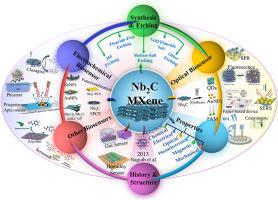碳化铌(Nb2C) MXenes的研究进展:合成、性能、电化学及光学生物传感应用
IF 12
1区 化学
Q1 CHEMISTRY, ANALYTICAL
引用次数: 0
摘要
自2011年发现以来,MXene一直是2D材料家族中研究最多的候选材料。实验上,到目前为止已经发现了30多种不同的MXene。其独特的物理化学性质使其在光催化、电化学和光生物传感、能量产生、电化学储能和催化等领域具有广泛的应用价值。在所有MXene中,碳化铌(Nb2C)是最近发现适合应用的MXene成员,因为它具有独特的性能,包括高度兼容,具有广泛的功能基团,可以很容易地组合,具有小或不存在带隙的优异电学性能,以及具有非常有效的体内生物传感窗口。科学家和研究人员对Nb2C-MXene特别感兴趣,因为它是目前可用的几种非钛基mxene之一。本文综述了Nb2C-MXene的结构性质、合成方法和最新生物传感应用等方面的研究进展。然而,对于这种创新的二维材料的独特特性和重要的生物学用途,研究还不够全面。鉴于此,我们对Nb2C-MXene材料的合成和未来应用的研究现状进行了综述,特别是在电化学、光学、光热、气体和湿度生物传感器方面的研究进展。最后,我们总结了研究结果,并讨论了在一系列现实环境中提高Nb2C-MXenes效率的潜在未来前景,强调了沿途的障碍。本文章由计算机程序翻译,如有差异,请以英文原文为准。

Current developments in niobium carbide (Nb2C) MXenes: Synthesis, properties, electrochemical and optical biosensing application
Since its discovery in 2011, MXene has been the most studied candidate in the 2D material family. Experimentally, over 30 different kinds of MXene have been discovered so far. Their distinct physicochemical properties have made them useful in a large domain, such as photocatalysis, electrochemical and optical biosensing, energy generation, electrochemical energy storage, and catalysis. Among all MXenes, Niobium carbide (Nb2C) is the most recent MXene member to find suitable applications due to its unique properties, which include being highly compatible, having a wide range of functional groups that can be easily combined, having excellent electrical properties with small or nonexistent band gaps, and having a very efficient in vivo biosensing window. Scientists and researchers are particularly interested in the Nb2C-MXene because it is one of several non-titanium-based MXenes that are now available. Herein, we summarise the modern progress in the structural properties of Nb2C-MXene, the accessible synthesis methodologies, and the latest biological sensing applications. However, insufficient research provides a comprehensive understanding of the unique properties and significant biological uses of this innovative 2D material. In light of this, we have compiled a summary of current research on the synthesis and potential future uses of Nb2C-MXene materials, especially on recent electrochemical, optical, photothermal, gas and humidity biosensors. Last but not least, we summarise the findings and discuss potential future prospects for progressing the efficiency of Nb2C-MXenes in a range of real-world contexts, highlighting the obstacles along the way.
求助全文
通过发布文献求助,成功后即可免费获取论文全文。
去求助
来源期刊

Trends in Analytical Chemistry
化学-分析化学
CiteScore
20.00
自引率
4.60%
发文量
257
审稿时长
3.4 months
期刊介绍:
TrAC publishes succinct and critical overviews of recent advancements in analytical chemistry, designed to assist analytical chemists and other users of analytical techniques. These reviews offer excellent, up-to-date, and timely coverage of various topics within analytical chemistry. Encompassing areas such as analytical instrumentation, biomedical analysis, biomolecular analysis, biosensors, chemical analysis, chemometrics, clinical chemistry, drug discovery, environmental analysis and monitoring, food analysis, forensic science, laboratory automation, materials science, metabolomics, pesticide-residue analysis, pharmaceutical analysis, proteomics, surface science, and water analysis and monitoring, these critical reviews provide comprehensive insights for practitioners in the field.
 求助内容:
求助内容: 应助结果提醒方式:
应助结果提醒方式:


